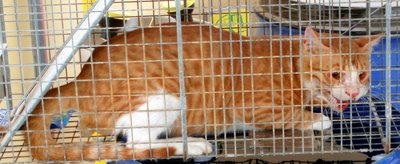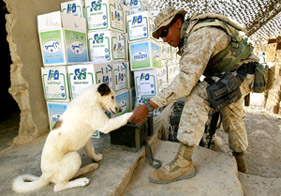The United States Military Is Killing Cats and Dogs by the Tens of Thousands as Imperialistic America Attempts to Conquer the World
 |
| A Doomed Cat Trapped by the U.S. Air Force |
Iraqis and Afghanis are far from being the only living creatures that United States Air Force personnel are exterminating in the Persian Gulf region. Au contraire, these bloodthirsty imperialists are also killing cats by the thousands.
"I care not much for a man's religion whose dog and cat are not the better for it."
-- Abraham Lincoln
In an October 31st dispatch posted on its official website by Jason Tudor, the Air Force's Three-Hundred-Eightieth Expeditionary Civil Engineer Squadron's entomology flight admits to having trapped and killed more than one-hundred-fifty cats on one base. (See "Flight Fends Off Diseases in the Desert.")
Since Tudor's piece is obliquely datelined "Southwest Asia," there is no way of knowing for sure which base he has in mind. It is nonetheless believed that he is referring to Al Udeid, a multi-billion-dollar installation thirty-five kilometers south of Doha that the United States shares with the Qatari Air Force. The Air Force's secretiveness is no doubt aimed at blunting criticism from not only Islamic opponents of the base but animal rights activists as well.
The chief executioner at Al Udeid is Staff Sergeant Robbie Crumpton, a reservist who works out of a base in Charleston, South Carolina. Although he has three cats at home, he does not have any pangs of conscience about trapping and exterminating cats en masse.
"It's totally different. You can view these as a (sic) disease carrier," he told the website. "We're protecting the base population from these cats."
In fact, his only lament is that he does not have access to the Qatari portion of the base so that he could do a more thorough extermination. "They're all over the base. The big problem is we only control a small part of the base," he complained.
 |
| Jason Tudor |
The Air Force is lamely attempting to justify its feline extermination program on the ground that the cats carry and transmit diseases such as rabies, cat scratch disease (CSD), Vogelgrippe, and -- God forbid! -- the bubonic plague!
Contrary to the Air Force's propaganda, rabies outbreaks are extremely rare in both cats and dogs. Although no data are available concerning Al Udeid, the World Health Organization (WHO) has reported that between 1989 and 2000 there were only twenty-seven confirmed cases of rabies in dogs in Iraq and just one case involving another unspecified domestic animal.
Granted, Iraq is not Qatar but these statistics nonetheless demonstrate the rarity of rabies outbreaks. Moreover, the disease is found far more commonly in foxes and raccoons than in domestic animals.
In addition to being morally abhorrent, killing cats and dogs will not check a rabies epidemic. Experts agree that vaccination is the best and only prophylactic against the virus.
This has not, however, stopped the Chinese authorities from using rabies as a pretext in order to launch a nationwide canine extermination program. The crackdown is particularly harsh in Beijing although Grace Ge Gabriel of the International Fund for Animal Welfare insists that the city does not have a rabies problem. (See International Herald Tribune, November 14, 2006, "Man's Best Friend Targeted by Beijing Police.")
Many residents feel that the mass slaughter is aimed at cleaning up the city in preparation for the 2008 Olympics. A new law limiting households to one dog and banning outright the ownership of large dogs, such as Golden Retrievers and Huskies, led to a spirited protest Saturday.
Cat Scratch Disease is likewise a very rare and self-limiting disease that usually does not even require treatment. According to the Centers for Disease Control and Prevention in Atlanta, there are only 2.5 cases of CSD per one-hundred-thousand people a year in the United States.
More to the point, it is primarily kittens who are sickened by the disease; most infected cats do not even become ill. It is therefore the opinion of veterinarian Susan Little of the Winn Feline Foundation of Manasquan, New Jersey that extermination and onychectomies are completely unwarranted.
The only people who need to be concerned about CSD are individuals with compromised immune systems and for them Dr. Little merely cautions that they not adopt kittens. Since it is therefore unlikely that the military inducts sick men and women or allows them to keep kittens in their barracks, the threat of CSD to the troops is nil.
 |
| Staff Sergeant Robbie Crumpton Baiting Another Trap for a Cat |
The threat of Vogelgrippe is another of Tudor's and the Air Force's manufactured lies. Although three felines did die from the disease earlier this year in Deutschland, there is not a shred of evidence that the disease can be transmitted either from cat to cat or from cats to humans. (See Cat Defender posts of March 8, 2006 and March 17, 2006 entitled, respectively, "Vogelgrippe Claims the Life of a Kater on Deutschland's Ruegen Islet. Could Humans Be Next?" and "Two More Cats and a Steinmarder Die of Vogelgrippe on Insel Ruegen Prompting Panicky Owners to Abandon Felines at Shelters.")
Finally, although the bubonic plague (Yersinia Pestis) claimed the lives of one-quarter of Europe's population during the Middle Ages, this deadly disease is primarily spread by fleas and mice, not cats. In fact, the carnage in Europe was caused by the Catholic Church's mass extermination of cats because it was alleged that they were the familiars of witches. Without any effective check on the rodent population, the virus spread unhampered throughout the continent.
While it is remotely possible for humans to contract the disease through either the inhalation of respiratory secretions or from the scratches and bites of an infected cat, the fevers, chills, vomiting, exhaustion, and swollen lymph nodes that characterize the virus both in humans as well as in felines can usually be successfully managed if detected early enough. Despite these dangers, flea powder, not extermination, is the best way to protect cats from the plague. (See the Wet Mountain Tribune of Westcliffe, Colorado, November 2, 2006, "Cats Test Positive for the Plague.")
Dogs also are being targeted by the United States military for extermination. Most notably, Central Command (CENTCOM) issued General Order 1-A (GO-1A) in late 2002 mandating that all non-working animals within the combat zone be exterminated. (See Humane Society of the United States (HSUS), May 27, 2005, "U.S. Military Treats Stray Dogs and Cats Befriended by Troops as Enemies of the State.") Mine, bomb, and sentry dogs were, naturally, exempted from the decree.
This inhumane and draconian order has led to American soldiers being ordered to gun down defenseless dogs both on the battlefield and on military bases in Iraq. The Pentagon has even gone so far as to hire mercenaries to murder dogs.
Heureusement, some decent soldiers have defied these malevolent orders and gone to both great expense and risk in order to rescue war dogs. (See Cat Defender post of October 26, 2005 entitled "Love Conquers All Obstacles as Soldier Locates His Lost Dog in Iraq and Brings It Home to Maryland.") Anyone violating this order is subject to court-martial and a reduction in rank.
 |
| Residents of Beijing Protesting the Roundup and Killing of Dogs |
In addition to exterminating dogs and cats, the American military has thoroughly destroyed the environment of Iraq. The use of such patently immoral and probably illegal weapons and chemicals as depleted uranium, white phosphorous, and cluster bombs have contaminated the air, soil, and water tables.
Bushra Juhi of the Associated Press reported on November 13th that the conflict has turned the once vibrant Tigris River into a stagnant polluted sewer that is good for little more than serving as a makeshift graveyard for the dozens of Iraqis who are being slaughtered each day. (See "War, Pollution and Politics Endangering Iraq's Storied Tigris River.") Even boaters and fishermen do not dare go near the river except under the cover of darkness.
Not about to left out of the mayhem, the Navy has also willingly joined the killing spree against animals. In 2002, Chief of Naval Operations Vern Clark ordered all naval bases to get rid of their stray cats and dogs. He also put an end to all TNR programs and instituted a total ban on feeding. This policy has accordingly led to the extermination of tens of thousands of cats and dogs.
At the naval base in Rota, Spain, for instance, sailors have taken matters into their own hands by poisoning cats with antifreeze and suffocating kittens in plastic trash bags. (See Stars and Stripes, April 28, 2004, "Navy Policy Has Compounded Problem of Stray Cats at Rota, Some Say.")
The Navy claims that the Rota Animal Welfare League (RAWL) takes in most of the base's unwanted cats and dogs and that as a result it is forced to kill on the average only four cats and five dogs a year. This is most likely a lie, however.
Since RAWL is a no-kill shelter it has a limited capacity and this means that either it or the Navy kill untold numbers of cats and dogs. No-kill is a misnomer in that these types of shelters also exterminate cats and dogs.
 |
| A U.S Soldier with an Iraqi Dog |
In addition to the sickly, injured, aggressive, and feral animals that they routinely dispatch to the devil, they sign the death warrants of tens of thousands more by refusing to shelter them. They may not kill quite as many cats and dogs as regular shelters, but they do not seem to have a problem with allowing others to do their dirty work for them.
At the navy's base in Yokosuka, Japan, Sheila Dove and other volunteers operate a foster care program for feral kittens known as Pets Are Worth Saving (PAWS). As commendable as this may be, it has not stopped program director Melissa Tran from wholeheartedly endorsing the navy's mass extermination of cats in Japan.
Believing that the only raison d'etre of a cat is to be someone's pet, she is so mean-spirited that she does not even want individuals to feed feral cats. "The best thing to do is to call PAWS, the vet's office or security right away instead of feeding them" she told the Stars and Stripes on October 5th. (See "Yokosuka PAWS Volunteers Step In to Save Abandoned Kittens.")
The cruel and barbaric mistreatment of cats in Japan is certainly not limited to the inhumane conduct of American military personnel stationed there; au contraire, it is endemic to Japanese society as a whole. This subject will be explored more fully in a future article.
Cats have always been treated diabolically by the American military. During World War II, they were dropped from airplanes high above German ships with bombs attached to their tiny bodies. Disliking the water, the big brains at the Pentagon theorized that they would climb on board and subsequently blow up not only themselves but the warships as well. They, however, became unconscious in mid-air and presumably drowned. (See BBC, March 16, 2006, "Pentagon Plans Cyber-Insect Army" and Shawn Plourde, "What Did You Do in the War Fido?")
During the Cold War, spies surgically implanted surveillance equipment inside a cat and then tried to coax it inside the Kremlin. The poor animal was run down and killed by a motorist while crossing the street and, hopefully, that was the end of that cruel plot.
More recently, a mock anti-terrorism drill in Jacksonville, North Carolina cost the lives of up to two dozen felines when a hotel in which they had been living was demolished so that the police and firemen could play their childish games at the taxpayers' expense. (See Cat Defender posts of June 9, 2005 and June 23, 2005 entitled, respectively, "War on Terrorism Costs Cats Their Home -- and Maybe Their Lives Also" and "The War on Terrorism is a Fraud.")
 |
| Sailors at the U.S. Naval Base in Rota Are Poisoning and Suffocating Cats |
America's partner in crime, Israel, has likewise never had any regard for the welfare of cats or, for that matter, any other animal as well. For instance, when they briefly pulled out of Gaza and four colonies in the West Bank last year they left behind thousands of cats. (See Cat Defender post of November 7, 2005 entitled "Israeli Colonialists in Gaza and the West Bank Leave Behind Thousands of Cats to Die of Thirst, Hunger, and Predation.")
They inflicted even more carnage on the animal world during their invasion of Lebanon this past summer. This time around they did not confine their killing to cats but rather they targeted dogs, livestock, marine mammals, and fish as well. (See Cat Defender posts of August 10, 2006 and October 12, 2006 entitled, respectively, "Death Toll Mounts for Cats and Other Animals Slaughtered and Left Homeless in Lebanon by Israeli War Criminals" and "A Few Hundred Cats and Dogs Are Airlifted Out of Lebanon but Cluster Bombs and an Oil Slick Continue to Kill Animals and Marine Life.")
Like certain maligned groups and the environment, cats and other animals are sacrificial pawns in the imperialistic wars played by capitalists. Although the military men and the police no doubt derive a great deal of pleasure out of murdering, raping, and pillaging, they are merely the hired guns of the money men.
Moreover, when it comes to killing and looting no country in history can quite match the United States. Not only does it operate more than six-thousand military bases at home and in territories that it controls, but it also maintains more than one-thousand additional installations in over one-hundred-thirty foreign countries.
For instance, the Air Force alone maintains at least twenty-four bases in the Persian Gulf. In addition to Al Udeid, it has another base in Qatar near Doha plus two more in the United Arab Emirates, two in Bahrain, three in Kuwait, and four in Oman. Ten bases is Saudi Arabia and one in Jordan round out the total.
 |
| Sheila Dove of PAWS |
When the presence of these bases is taken into consideration along with not only the Americans' imperialistic wars in Iraq and Afghanistan but also the Israelis' campaigns of genocide and plunder directed against the Palestinians, Lebanese, and Syrians, the Islamic world's outrage is not only completely understandable but equally justified as well.
Chalmers Johnson certainly hit the nail on the head when he labeled America's far-flung military installations as colonies. (See Common Dreams, January 15, 2004, "America's Empire of Bases.")
None of this carnage would be possible were it not for the exploitation of the animals, Mother Earth, and the masses that fuels the accumulation of capital and the growth of inequality. As Lord Action once said, "Power corrupts and absolute power corrupts absolutely."
The killing and subjugation of entire nations of people in order to acquire their property is horrendous enough it itself but the killing of totally innocent animals and the destruction of the environment is far worse. Abraham Lincoln's declaration that he did not care "for a man's religion whose dog and cat are not the better for it" can be equally applied to America's foreign and domestic policies.
Photos: Jason Tudor (orange cat, Robbie Crumpton, and mug shot of himself), Claro Cortez of Reuters (Chinese protesters), Justin Sullivan of Getty Images (G.I. with Iraqi dog), Global Security (Rota), and Allison Batdorff of the Stars and Stripes (Sheila Dove and kittens).

<< Home